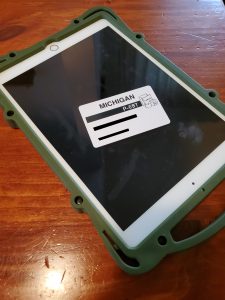
In spring of 2020, schools and the state of Michigan raced to get emergency food assistance and devices for remote school login to students across the state–many of whom lacked access to broadband connections or grocery stores to use them.
“Last mile broadband” is a hot topic as we look back at the last year of widely varying connectivity experiences. Who had access to it, and who didn’t, made a big difference in our ability to keep up with jobs, schooling, vaccine scheduling, public meetings, contactless grocery shopping, etc. Smaller rural towns and neighborhoods within our larger cities shared the harms of lacking high-quality connections at reasonable cost. Whether it was the children who couldn’t keep up with class for lack of internet access or the business that struggled with the pivot to remote work and curbside pickup, these harms are much more visible now than pre-COVID.
The American Rescue Plan named broadband internet connectivity alongside water and sewer as essential infrastructure for this reason, and we expect to see substantial investment across the country as a result. As the sense of emergency fades, and the free home internet programs and ad hoc solutions with it, these investments will determine whether COVID drives a permanent increase in access—or just a blip before cutting off communities’ access again.
The major national telecom companies expect to benefit from windfall investments in broadband, but writing checks to pay for their wires and switches won’t be enough to truly expand internet access: community leaders must also identify and address the gaps at the household level.
Building a Better Map of Service Gaps
As a fundamental challenge, the very maps we’re using to identify who has access are flawed: the availability data is self-reported by providers, and a neighborhood might be reported as having broadband access if even just a single household is in the service area. Additionally, having broadband access is defined as whether service of 25 Mbps download / 3 Mbps upload is available, a standard that’s both very inadequate for our daily uses—and also makes no effort to determine whether the service is within financial reach of the household in question.
We need much better data on the granularity of service, the speed, and the affordability to inform our policies around access. The Merit Network’s Michigan Moonshot project is one effort to improve our understanding of real, actual current access: encourage your local community members to participate in order to help build the map.
Getting Service from the Street to the Resident
Even if an address has access to true high-quality broadband services, and even if that service is affordable, the residents at that address may not be able to make use of it. Just like having a water main in the street also needs leads to the house and internal plumbing before water comes out of the tap, broadband access can’t stop at the utility pole.
Jean Hardy, Assistant Professor of Media and Information at MSU, identified for me two additional barriers that need to be considered even once availability and affordability are in place:
- Devices: does the household have a computer able to take advantage of the connection? Neither a smartphone or an internet appliance (like a “smart tv”) is adequate for the range of uses a household has.
- Digital literacy: does the household have trusted sources of tech support and how-to knowledge? From understanding an ISP’s offerings to protecting themselves against identity theft and phishing, residents need community networks and organizations that can help them build knowledge and comfort.
Prof. Hardy noted that there are organizations working to address these needs in some places, ranging from Northern Michigan University’s Education Access Network, tackling some of these needs in the rural UP, to the Detroit Community Technology Project’s Equitable Internet Initiative, working on internet access and digital literacy in Detroit neighborhoods. Efforts like these can be learned from, supported, and used as inspiration for other communities.
The Municipal Role
With broadband access traditionally a role of a small group of large corporate or nonprofit entities, local government leaders may struggle to see their role in this issue—but without local leaders identifying and advocating for their communities’ needs, state and telecom attention may deliver theoretical access without effectively connecting anyone.
School districts will be essential partners for municipalities in this work, as they were thrust into not just transitioning curriculum online but often in providing devices, connectivity, and tech support to their students. One superintendent noted that internet was almost as important as nutrition for students’ ability to keep learning this past year, and pointed to the battlefield medicine approaches they were forced to take, like offering Wi-Fi in school parking lots for drive-in class access.
Looking beyond basic home access needs, DDAs, Main Streets groups, and other business organizations can also inform this work: what have been the barriers in continuing business via online ordering, curbside pickup, or remote work? How do those hurdles inhibit economic recovery and growth of new businesses and jobs?
Some communities have gone further with their evaluations of needs, taking the step of establishing municipal broadband utilities to expand access. Holland’s Board of Public Works has included broadband service in parts of the city for some years, alongside their water, sewer, and district heating utilities, and is considering expanding that. While there are statutory hurdles to rolling out municipally owned broadband infrastructure, this approach allows the community to take the lead in expanding access to service, rather than waiting for the large private providers to get around to it, and offers more options for affordability and other downstream access needs.